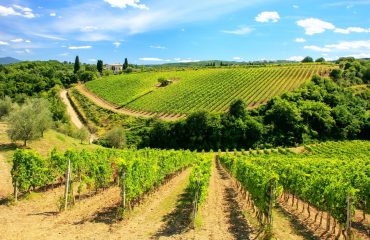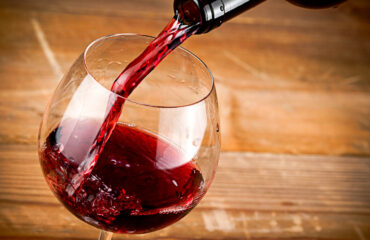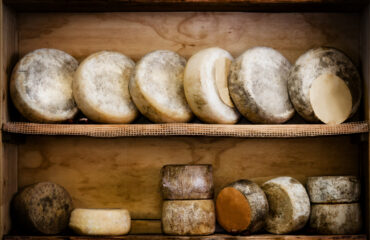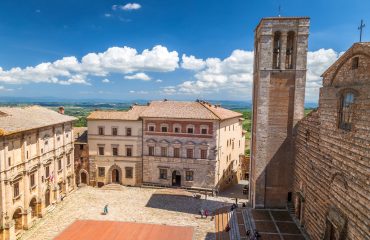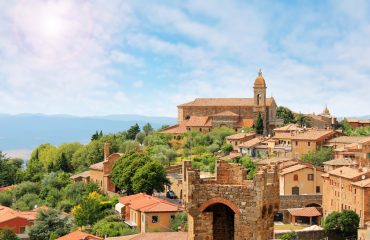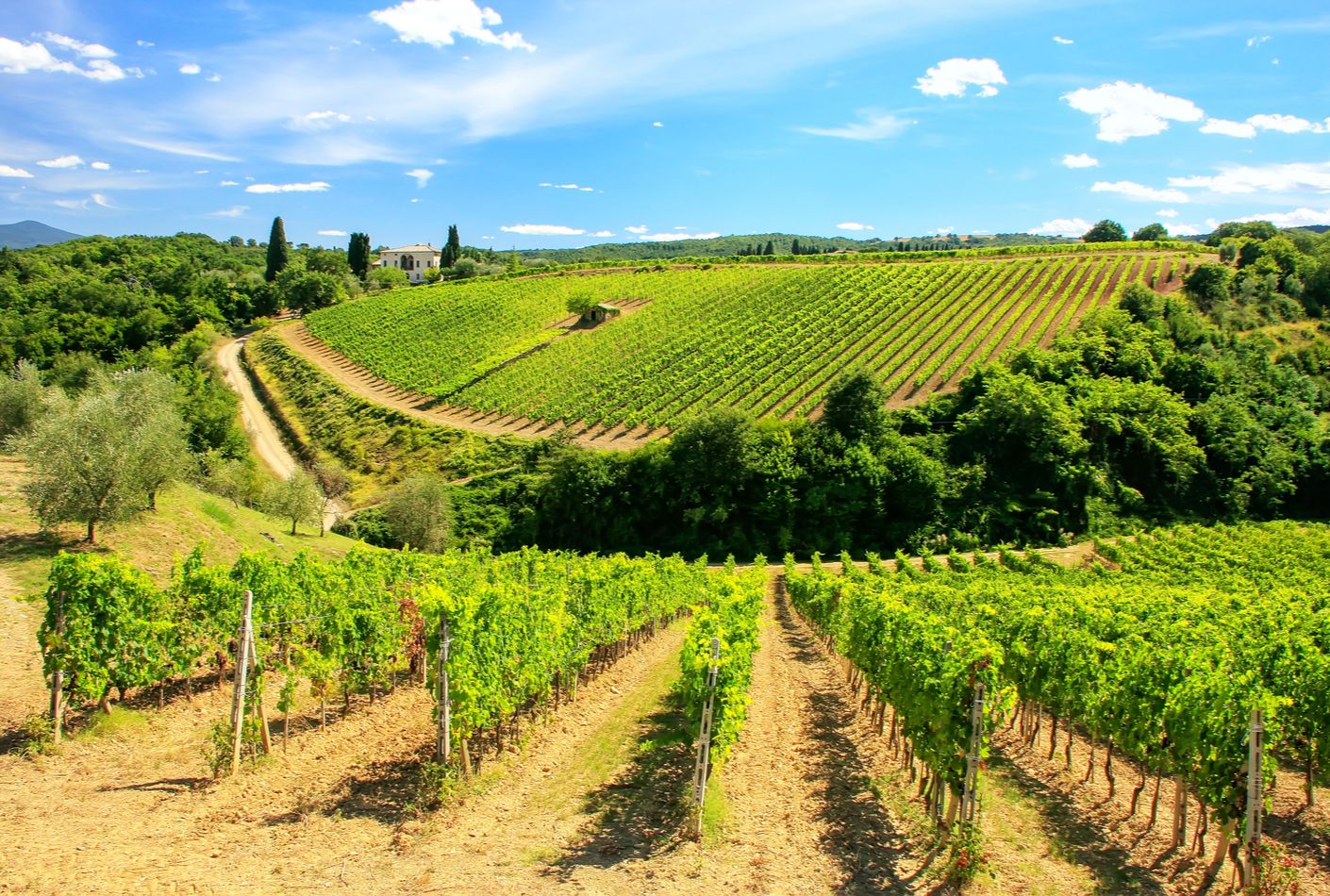
TUSCAN TRAIL
A food & wine trip to Florence, the Orcia Valley and the Tuscan coast
Starting from €24.000 (for two guests)
- Sample a range of local specialities, including cold cuts, cheese and gelato, on a food tour of Florence
- Discover traditional recipes and pick up precious tips in a hands-on cooking lesson led by a professional chef
- Lap up wonderful views of the Tuscan hills while sipping glasses of Italy’s best-known wines
-
Duration11 days / 10 nights
-
Category
-
Day 1
Arrive in Florence
Upon arrival at the airport or train station, meet your private driver and reach your hotel in Florence where you will be staying for 4 nights.
Following check in, which will take place after 2:00 or 3:00 PM, spend the rest of the day at leisure.
-
Day 2
Florence food tour & visit to the Uffizi Gallery
Bite your way through Florence’s streets and squares on this delectable food tour. You will dig into the belly of the city and discover that Florence’s gastronomic specialities are worthy rivals of its artistic treasures – and are just as ancient, owing to the Italians’ long-standing obsession with food.
Florentine Catherine de’ Medici, who became queen of France, is a famous ambassador for a long list of Italian epicureans. When she moved abroad in 1533 she insisted on taking her favourite cooks and preserving her Italian traditions and habits as she disliked French cuisine. She is said to have ignited the French passion for cooking and introduced many culinary innovations to the country. Some claim that dishes considered today as traditional French creations, including crepes, béchamel and onion soup, were actually brought into France by Catherine. She is also credited with giving the French court its first taste of olive oil, artichokes, truffles and figs and with teaching the French to use a fork at table!
Your private guide will lead you on a stroll through the historic centre, introducing you to popular local temptations. An indispensable ritual in the life of every self-respecting Italian is the prima colazione… Begin your day like a local, delighting your senses on a croissant and an expertly brewed coffee or cappuccino at the bar. You will then follow a tasty trail through the bustling Mercato Centrale, one of the city’s oldest markets. Admire stalls brimming with an enticing assortment of fresh, seasonal produce that will make your mouth water, feast your eyes on crisp green vegetables, delicious cheeses, top quality charcuterie and try out the regional favourites.
Your eating adventure also covers a deli shop, a winery and a gelateria. Indeed, no Florence food tour would be complete without a taste of gelato. Ice cream is an age-old treat, dating back thousands of years. Frozen desserts are recorded as far back as 3,000 BC when Asian cultures began consuming crushed ice and flavourings. Our modern gelato may well have its origins in a recipe brought back to Italy from China by Marco Polo. However it was during the Renaissance in Florence, under the rule of the Medici family, that the great tradition of Italian gelato began. Legend has it that among the chefs that Catherine de Medici would have loved to have employed at the French court was Ruggeri, the inventor of a prize-winning frozen dessert, but it is to 16th century Florentine architect, painter and sculptor Bernardo Buontalenti that we owe gelato as we know it today. His addition of milk and eggs to the mixture was a genial contribution to this world-acclaimed delicacy.
Later, it’s time to discover Florence’s most cherished artworks on a tour of the Uffizi Gallery. Your guide will lead you through the halls and highlight the masterpieces no visitor to the city should ever miss. The treasure trove you see today originated over four hundred years ago as the Grand Duchy’s administrative centre having been built at the request of Cosimo I de’ Medici to house the Florentine magistrates’ judiciary offices – called uffizi in old Italian. Construction work began in 1560 under the direction of architect Giorgio Vasari and was completed by Bernardo Buontalenti in 1574. Only 7 years later, in 1581, Francesco I de’ Medici, Cosimo’s son, set up his private gallery inside the building’s rooftop loggia adorning it with all sorts of precious artefacts, including cameos, stones, jewellery, bronzes, scientific instruments, paintings and statues. As time passed the Medici family’s collection was enriched until it was eventually bequeathed to the city of Florence by the last member of the dynasty, Anna Maria Luisa de’ Medici, in 1743. The gallery first opened to the public in 1769 and has delighted visitors ever since with its vast store of wonders.
Where else in the world could you find such a dazzling, prestigious collection of Renaissance marvels? Over sixty rooms display stunning works of art from the 12th to the 16th centuries, including classic paintings by well-loved artists Cimabue, Giotto, Michelangelo, Raphael and Titian. Your guide will treat you to the insider information you need to appreciate the significance of the pieces on display and the circumstances in which they were produced and commissioned. Who could resist the charms of Botticelli’s Venus emerging from her shell, as pure and perfect as a pearl? The grace of Leonardo’s Gabriel announcing the glad tidings and the thrill of meeting an illustrious Italian couple, immortalised in Piero della Francesca’s finely rendered portraits are among the lasting Florentine memories you will take away with you.
-
Day 3
Day trip to Chianti with a visit to a cheese farm, lunch at a Cinta Senese farm & a tour of a wine estate
Relish Chianti’s full range of delights on this flavoursome countryside excursion from Florence. Gourmands will have the opportunity to visit two farms and a wine estate, taste local gastronomic specialities and discover that Chianti is indeed a fine wine producing region but is also so much more.
The first stop will bring you to an estate well-known for its fine cheeses, extra virgin olive oil and wine. On this 140-hectare farm, cheese has been produced by hand according to traditional methods since 1992 using exclusively Sardinian sheep milk. Years of experiments have resulted in more than fifteen different types of cheese, from traditional Pecorino to a sophisticated Blue. A member of staff will give you a tour of the cellar and vineyard and explain the different stages in the dairy production process. Sit down to a special tasting of four cheeses, three wines and olive oil before moving on to your next destination.
Upon arrival at a farm located near Castellina in Chianti you will be greeted by the owner and his wife who will give you an introduction to farm life and explain the activities carried out on the estate. Here, lovingly cultivated vineyards and olive groves are expertly turned into fine Chianti and “liquid gold” while a rare species of pigs, called Cinta Senese, breed freely. At the top of the list of species at risk of total extinction in the 1990s, the Cinta Senese today is no longer endangered and its meat has been awarded the DOP classification from the European community. Native to this region and probably dating back to the Middle Ages, the Cinta Senese pig was once a popular farm animal and was even depicted in a famous 1338 fresco by Ambrogio Lorenzetti housed inside Siena’s Palazzo Comunale. The species owes its name to the black coat with a white sash (called a cinta in Italian) that runs across its shoulders, sides and front legs. After visiting the property and salumificio, top off your morning with a delicious Tuscan lunch. Tasty inclusions might consist of a bruschetta with extra virgin olive oil, a selection of cold cuts, Parmigiano cheese, a pasta dish, a second course made of pork, all washed down with full-bodied Chianti wine.
In the afternoon a pleasant ride through the splendid Tuscan hills will bring you to a renowned Chianti estate. Here, on a tour of the property, you will get to know about wine-making and ageing methods, become familiar with the particular features and regulations that define Chianti Classico and discover the unique characteristics of the terroir and climate that make wines produced here so special. Top off your day with a tasting of the estate’s wines and a toast… cheers to Chianti!
After the visit your private chauffeur will drive you back to your accommodation in Florence.
-
Day 4
Truffle hunt & lunch
Nose your way through the woods on an exciting truffle hunt. Adventure-seeking foodies will embark on a quest for these exquisite gifts of nature and delight in a mouth-watering Tuscan meal.
Truffles are one of the world’s most expensive, sought-after delicacies and the Italian white variety – growing from October through December – is the most valuable of all, with a market price of up to € 6,000 per kilo. The mild climate and terroir rich in mineral salts typical of the countryside surrounding San Miniato contribute to the growth and flavour of delicious truffles – as well as top-class olive oil and wine.
You begin your day with a 70-minute ride from Florence to Forcoli. Here you will visit a small truffle museum owned by a local family of truffle hunters who pride themselves on supplying the kitchens and tables of famed chefs and the most discerning of palates. The family’s passion for truffles has been handed down for four generations, since the early 1920s. Among their achievements is that of having found the biggest, priciest truffle in the world. In 2007 thanks to their cherished dog, Rocco, a giant white truffle weighing 1,497 kilos emerged from the soil. We can’t promise you’ll be quite so lucky but keep your fingers crossed and your nose to the ground.
You will hear an introduction to the family’s history, activities and values and understand the importance of working in harmony with the land. Indeed only uncontaminated nature rewards us with its most wonderful fruits. Tuscany, with its pure, unspoiled green hills, is very generous all year long, making this truffle experience a gratifying activity in all seasons. Several kinds of truffle – including the black truffle, the scorzone truffle, the whitish truffle and the rare white truffle – grow in different areas and different seasons and you will learn about the characteristics of each type.
Then, head for the woods and enjoy an exhilarating truffle hunt accompanied by an experienced truffle seeker. It is actually the dogs who will lead you on the trail, as they follow this unique and precious scent through the trees digging out aromatic treasures. With guidance from your truffle seeker, you will identify different plant species, get to know the ideal habitat for truffle growth, find out why truffles are considered an icon of the slow food movement and discover how dogs are trained to detect these woodland treats.
Later, sit down to a tasty truffle-based meal. Highlights might include truffle bruschetta, cold cuts with truffle, pecorino cheese served with truffle honey, potato flan with goat cheese and truffle, risotto with truffle fondue, tagliolini pasta with truffle butter, fried eggs with truffle… Buon appetito!
After lunch explore Tuscany’s truffle capital. The enchanting hilltop town of San Miniato hosts a famous truffle fair every year in November attracting chefs, journalists and specialists from all over the country. Roam its pretty streets taking in splendid views of the Arno Valley below before returning to your hotel in Florence.
-
Day 5
Private transfer from Florence to the Orcia Valley with a guided tour of Siena en route
After breakfast and check out meet your private driver outside your hotel in Florence and relax on the ride to the Orcia Valley. En route stop to enjoy a private tour of Siena, a beguiling medieval town recognised by UNESCO as a World Heritage Site.
Your guide will be waiting at the meeting point and make sure no fascinating detail eludes you as you follow a stirring trail. No doubt you will notice the symbol of Siena, the she-wolf and twins, which links the town with its Roman origins, though it was not until rather later that this centre bloomed into the glorious gem you see today. Legend has it that Remus’ sons escaped to safety here after the murder of their father by the children’s uncle Romulus, the founder of Rome. Siena is indeed immersed in legends, steeped in ancient traditions and replete with true stories of battles and bravery. The town is also richly peppered with wondrously preserved monuments, churches and architectural marvels, attesting to its extraordinarily rich and riveting past. Between the 13th and 16th centuries the town revelled in a golden age becoming one of the most powerful banking centres on the continent. A number of great artists were called upon to embellish its piazze and buildings securing its lasting fame.
Countless treasures await you inside the black-and-white striped Gothic Cathedral of Santa Maria Assunta: the wonderfully inlaid marble flooring, the rose window by Duccio di Buoninsegna, the marble pulpit by Nicola Pisano, Donatello’s statue of St. John the Baptist and the gorgeous Piccolomini Library. Well-known for its illustrated hymn books and beautifully preserved Renaissance paintings by Perugian painter Pinturicchio, the library was built at the request of Cardinal Francesco Piccolomini, Archbishop of Siena, to honour the memory and manuscript collection of his uncle Pope Pius II. A radiant fresco cycle depicts a glorified version of the life of the pope as well as mythological scenes and ornate decorative motifs, all rendered with the greatest skill and painstaking attention to detail.
Not to be missed is also the shell-shaped Piazza Del Campo, for centuries the pulsing heart of the town’s social and political life and known the world over as the atmospheric setting of the Palio. Your guide will elucidate the origins of this famous horse race that still takes place regularly twice a year in July and August and help you understand why the event continues to play a significant role in fostering a Siennese sense of belonging, re-evoking the rivalry that flourished among its seventeen contrade and its legacy of ward-centric culture.
The looming Torre del Mangia, the elegant red-brick buildings and the medieval aura of the city’s narrow winding streets are among the unforgettable impressions to be savoured in this delightful wellspring of wonders.
After the tour and some free time for lunch your private chauffeur will drive you to your hotel in the Orcia Valley where you will be staying for 3 nights. After check in spend the rest of the day at leisure.
-
Day 6
Visit to a Montepulciano wine estate and guided tour of Montepulciano & Pienza
Soak up the secrets behind one of Italy’s oldest wines on this full-day excursion to Montepulciano.
The earliest documented reference to Montepulciano wine dates back to 789 AD, when the cleric Arnipert offered the Church of San Silvestro in Lanciniano a plot of land planted with vineyards located on the estate of the Policiano Castle – the name by which Montepulciano was known in the Middle Ages. After more than 1,200 years Montepulciano wine continues to triumph…. Find out why while you sip the morning away in the Tuscan countryside.
Your private chauffeur will pick you up at your accommodation and drive you to a wine estate, well-known for its fine Vino Nobile di Montepulciano and much praised Syrah. Once the property of local counts, since 1990 the estate has been run by a prestigious Tuscan family with a long history of wine-making. Indeed, their association with wine began over six centuries ago, in 1385, when one of the ancestors became a member of the Winemakers’ Guild of the city of Florence. After twenty-six generations the owners still maintain their reputation, both locally and abroad, as leading and forward-thinking producers, capable of balancing innovative decisions with a steadfast respect for tradition and the territory. On a tour of the cellar, accompanied by a member of staff, you will discover what sets Vino Nobile di Montepulciano apart from other Tuscan wines. The different stages in the wine-growing process will be explained, as well as the distinctive characteristics of the terroir and climate that make wines produced here so special. You will also learn about the strict regulations that define Vino Nobile, including which grape varieties and blends are allowed, together with the legal requirements for ageing in oak barrels. But every estate has its own precious formulas which you will have the chance to appreciate during a delicious light lunch paired with a selection of wines.
In the early afternoon a 25-minute drive will bring you to Montepulciano. Standing proudly on top of a steep hill, overlooking the Orcia Valley on one side and the Chiana Valley on the other, the town boasts a remarkably well-preserved medieval and Renaissance urban layout which has remained largely untouched since 1580. Rural, yet chic and romantic, Montepulciano is Tuscany’s pride and joy. A collection of sumptuous palazzi punctuates the town centre, proclaiming the importance of the site and the wealth of the local nobility during the 14th and 15th centuries, although it was not until the 1500s, under the rule of the Medici dynasty, that Montepulciano enjoyed its golden age. Amble along the main Corso and reach Piazza Grande, the very core of the town. Here you will find the beautiful unfinished Duomo and the imposing Palazzo Comunale dominated by a clock tower. Climb to the top for a sweeping view of Montepulciano and the surrounding countryside. The square is the setting for the folkloristic Bravio delle Botti, a wine barrel racing contest held every year in August that pays homage to Montepulciano’s most important trade. Indeed the history and fame of this small town are inextricably linked to its world-renowned, full-bodied Vino Nobile. To get a true feel for the town don’t forget to take a peek inside one of the atmospheric subterranean wine cellars, hidden beneath its buildings. Saunter through the steep, narrow alleys lined with shops selling gastronomic specialities, leather goods and all sorts of rigorously hand-made crafts before setting off for another Tuscan gem.
Time seems to have come to a standstill in Pienza. Conceived as a model city, this is the best-preserved Renaissance town in Tuscany. Pienza, meaning the city of Pius, was founded by Pope Pius II who wanted to transform his lacklustre place of birth into the perfect embodiment of Renaissance values. He commissioned architect Bernardo Rossellino with the task of building a town in accordance with humanist planning principles. The result is a harmonious 15th century urban centre which is still surprisingly intact. Make your way through the olde worlde streets to the small but perfectly proportioned Piazza Pio II, the heart of Pienza’s religious and political life for almost six hundred years. Here you will admire the Cathedral of Santa Maria Assunta and the elegant palazzi that together make up one of the finest corners of Tuscany. A walk along Via dell’Amore – Lovers’ street – and Via del Bacio – Kiss street – will make you fall head over heels for Pienza. You might also be interested to know that the town holds the title of the capital of pecorino. Stop to refuel with a bite or two of this flavoursome cheese then ride in comfort, through the splendid Tuscan landscape, back to your accommodation.
-
Day 7
Cooking class & lunch
Language and proverbs reflect the customs, culture and tastes of a territory. It may come as no surprise that many traditional Tuscan expressions are inspired by gastronomy, culinary habits and the act of eating or sharing food, revealing the age-old origins of the region’s food-focused way of life.
Here are three sayings that are evidence of how food has always been central to the hearts and minds of Tuscans and is an essential component of the territory’s culture. Né amico riconciliato, né pietanza due volte cucinata conveys Tuscans’ belief that once your trust in a friend has been broken, your relationship will never be the same again – just like a dish never tastes the same after it has been reheated. Più vale un pan con amore che un cappone con dolore means that a simple piece of bread made with love is better than a succulent capon made with anger, as love is the best of ingredients. A tavola non si invecchia – translating as “one never grows old at the table” – is a tribute to the dinner table and to long-lasting Sunday lunches. An unbroken flow of wine, food and good conversation enlivens spirits, raises energy levels and increases pleasure for all dining companions.
Dip further into Tuscan lifestyle and unlock the secrets behind the region’s celebrated cuisine on a private cooking lesson. Your chef will guide you through the preparation of a delicious meal in true Tuscan style. You will be taught how to match different flavours, discover local recipes and culinary traditions, try out infallible cooking techniques and pick up tips you can use to impress your friends back home at the dinner table. After the cooking class tuck into the meal you just prepared… Buon appetito!
-
Day 8
Private transfer from the Orcia Valley to the Tuscan coast with a guided tour of Montalcino and the Abbey of Sant’Antimo & lunch at a Brunello wine estate en route
After breakfast and check out meet your private driver outside your hotel and relax on the ride to the Tuscan coast. En route learn all about one of Italy’s most prestigious wines on a full-day excursion to the kingdom of Brunello.
The first stop on your excursion will bring you to Montalcino, internationally known as the capital of the Brunello wine region. Sitting strategically about 560 metres above sea level, on a hill overlooking the Orcia and Asso Valleys, Montalcino was once an influential Etruscan settlement. The town has undergone few changes since the 1300s, when it enjoyed its golden age as a stronghold belonging to the nearby city of Siena. Protected by fortified walls, Montalcino has indeed maintained its medieval appearance and offers stunning views of the surrounding landscape from the top of its imposing 14th century fortress: hills crossed by country roads winding though vineyards and olive groves, a canvas splashed with golden sunflowers and deep green cypress trees. From here enjoy a leisurely stroll through the town’s narrow alleys lined with wineries, craft shops and eateries and listen as your guide points out its major landmarks. Highlights include the Romanesque-Gothic Church of Sant’Egidio, the monastery of Sant’Agostino and the quaint Piazza del Popolo overlooked by the looming clock tower of the Palazzo dei Priori.
A short drive will then bring you to an estate located west of Montalcino. The land belongs to an illustrious Florentine family that has been producing wine for some seven hundred years. The family owns six estates and some of Tuscany’s most highly regarded vineyards and aims to become the reference producer of fine Tuscan wines. Indeed, among their core values is the promotion of the region’s different traditions and territories by producing high quality wines, each an expression of a specific, unique terroir and environment. Accompanied by a member of staff, you will enjoy a tour of the cellars and discover the different stages in the wine-making process, from the moment of harvest to the choice of the image on their wine label, featuring a condottiero on horseback. You will also get to know the strict regulations that define the production of Brunello which must contain 100% Sangiovese grapes and be aged in oak barrels for two years and at least four months in a bottle before being released. But every estate has its own precious formulas which you will have the chance to unravel and applaud! After the visit sit down to a delicious light lunch made with locally sourced products and washed down with a selection of first rate wines.
Later, rejoin your guide and chauffeur and reach the Romanesque Abbey of Sant’Antimo, an extraordinary example of medieval monastic architecture, standing in all its solitary splendour in a valley near the small town of Castelnuovo dell’Abate. As your guide will explain, the present church was built in the 12th century, though its origins are believed to stretch much further back in time. Indeed, according to legend, Holy Roman Emperor Charlemagne is credited with the abbey’s founding in the late 700s. He is said to have stopped here with his troops on his trip back from Rome, to pray for deliverance, after his soldiers had been struck by a plague. An angel appeared to Charlemagne telling him to prepare an infusion with a local herb. The cure was successful, the army was saved and, as an expression of gratitude, a church was built on this spot. The Carolingian chapel (now used as a sacristy and not open to visitors) and the crypt beneath the church have survived from the original 8th century structure. The solemn interior consists of three naves divided by arches resting on columns with alabaster capitals, all carved with geometrical, human, animal and floral motifs. Once one of the wealthiest and most powerful religious institutions in Tuscany, the abbey held sway over numerous parishes, castles and manors, rivalling Siena for the control over the region. Its vicinity to the Via Francigena – the ancient pilgrims’ route that linked Rome to Canterbury – contributed to enhancing the abbey’s prestige until the 14th century, when a long period of decline began. Today Sant’Antimo is managed by a community of Olivetan monks who follow the precepts of the Benedictine rule and its “pray and work” lifestyle. Visitors can see the fruits of their labour in the adjoining pharmacy where an array of products, including honey, sweets, herbal teas, beer and cosmetic products are on sale.
After the tour your chauffeur will drive you to your hotel near the coast, where you will be staying for 3 nights. Following check in spend the rest of the day at leisure.
-
Day 9
Visits to two coastal wine estates & lunch
-
Day 10
Day at leisure
Enjoy a full day at leisure at your hotel.
-
Day 11
Arrivederci Tuscany!
After breakfast and check out, which will take place before 10:00 or 11:00 AM, meet your private driver outside your hotel and head for the airport or your next travel destination.
- Four nights at a 5-star hotel in Florence (breakfast included)
- Three nights at a 5-star hotel in the Orcia Valley (breakfast included)
- Three nights at a 5-star hotel on or near the Tuscan coast (breakfast included)
- Private chauffeured transfers and car services with luxury vehicles, as per programme
- Private tours with expert licensed guides, as per programme
- Entrance tickets to museums and sites, as per programme
- Meals, as per programme
- Food tastings in Florence
- A visit to a cheese farm in Chianti with cheese tasting
- A visit to a Cinta Senese farm in Chianti with lunch
- A visit to a wine estate in Chianti with wine tasting
- A truffle hunting experience with an expert truffle seeker and his dogs
- A visit to a wine estate near Montepulciano with wine tasting and lunch
- A cooking class with an expert chef and lunch
- A visit to a Brunello wine estate with wine tasting and light lunch
- Visits to two coastal wine estates with wine tastings and lunch
- Full support from your travel designer before, during and after your trip
- City tax to be paid directly at the hotels
- Meals, other than those listed in the programme
- Tips
- This vacation is entirely customisable and can be tailored to suit your needs and preferences. The experiences featured in this trip give an idea of what we can arrange for you but you may modify the itinerary as you wish. You may include additional tours, remove activities that are not of interest to you, replace an activity with another one from our collection of recommended experiences, or ask us to create personalised experiences to meet your specific requests
- The order of the sites visited may change depending on your exact travel dates
- The itinerary may vary depending on the exact location of your hotels in Tuscany
- All experiences are subject to availability
- Although pre-booked tickets for the Uffizi Gallery will be provided, visitors will still have to pass through security points and therefore might have to wait in line
- When visiting churches and sacred sites, clothing should be appropriate for a sacred place. Shoulders and knees must be covered
- The visit to the cheese farm is a group experience. Other visitors might also join in. If you would like to enjoy a private tour please let us know so we may check availability
- The truffle hunt is subject to weather conditions
- Please advise of any food allergies or intolerances


